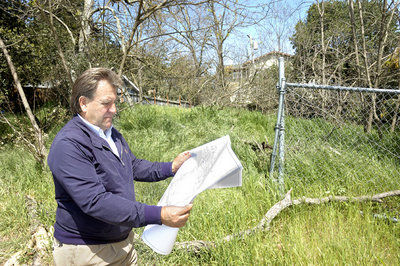
Habitat for Humanity is set to hammer the nails into an affordable housing plan designed specifically for families that live or work in Scotts Valley.
The Scotts Valley City Council, acting as the city’s Redevelopment Agency, agreed to give Habitat as much as $300,000 of its money for low-income housing, depending on how many units fit on the 10,000-square-foot parcel on Blake Lane.
Habitat for Humanity is a nonprofit that helps give lower-income households around the world a chance to own a home.
“We’re hoping to build three affordable housing units for low-income families and plan to start building by the end of the year,” said Melanie Shaffer Freitas, executive director of Habitat for Humanity in Santa Cruz County.
The households built will give preference to those who already live or work in Scotts Valley, and will carry a mortgage with no interest.
Families will be chosen for the Habitat homes based on three criteria, Shaffer Freitas said.
The criteria include a family’s need for the home. Habitat looks at a potential buyer’s present living situation to assess the need.
“Income is also a factor,” Shaffer Freitas said. “They have to be able to pay the mortgage.”
The third must is a family’s ability to participate in Habitat’s “sweat equity.” As part of a down payment, families chosen to live in a Habitat home are required to spend 500 hours helping build it.
The chosen families will work on the Blake Lane property off Scotts Valley Drive, between Scotts Valley Middle School and Erba Lane.
“There is not a lot of vacant, undeveloped land for sale in the county, and that’s what we were looking for,” Shaffer Freitas said of the spot. “And we wanted to be in Scotts Valley’s redevelopment area, and Blake Lane falls in that area.”
Scotts Valley has quite a bit of available land for affordable housing, according to city staff. The Blake Lane address’s placement within the city’s redevelopment boundary made it eligible for redevelopment agency funding.
Scotts Valley’s redevelopment agency has set aside 20 percent of its generated revenue for low-income housing since the 1990s. Currently, there is more than $3 million available for low-income housing that can only be spent to develop “affordable” homes in Scotts Valley. Low-income is defined at being 120 percent or less than the moderate income of $97,600 for a family of four.
Habitat’s project is in line with the city’s general plan housing element, which calls for about 100 additional affordable homes in Scotts Valley by 2014.
Before it is added to that affordable housing stock, the Habitat Blake Lane project still must go through the normal design review process, which will determine whether two or three attached units will fit on the property.
Fuse Architects, a Capitola-based firm known for progressive building, is on board and is donating a portion of its services to design simple yet attractive homes, Shaffer Freitas said.
Michael Bethke, board president of Habitat’s Santa Cruz County affiliate, said the project is going to set a new bar for affordable design.
“We’re really looking forward having this project tailored for Scotts Valley residents and the folks that work there,” he said.
Long known for his community service work, Bethke, 55, said he was excited to start Habitat’s first non-partnered development project in Scotts Valley.
Habitat already has two projects in Scotts Valley in which it has partnered with a development company and is in the process of building one home on Civic Center Drive and six units in the Polo Ranch development.
Councilmember Stephany Aguilar said she is thrilled about Habitat’s newest Scotts Valley project, especially since the nonprofit offers affordable for-sale housing for families.
“It’s a long time coming. I’m quite pleased that it’s finally happening,” Aguilar said. “Habitat provides a market niche that’s affordable and available to the community. It’s very unique and very much needed.”
At a glance
• For inquiries about the application process to purchase a Habitat home, call 469-4663.












